Mold Toxins and Parkinson's Disease:
There is a strong link between specific mold neurotoxins and neurodegenerative diseases such as Parkinson's. One can have a urine test for poisonous mold toxins (called mycotoxins) to detect for elevated levels of these neurotoxins. Mold types, detection, mitigation and detoxification are all covered.
Climate change is causing more hurricanes, floods and rising water leading to water intrusions and an increase in mold infestation. Humans are spending record amounts of time indoors exposed to mold toxins harbored by drywall, carpeting, upholstery, ceiling tiles, ventilation ducts, plants (and soil), etc. There are over 100,000 species of molds but only about two dozen cause health problems for humans (mostly inflammatory and immune response) and even fewer are known to be related to Parkinson's disease.
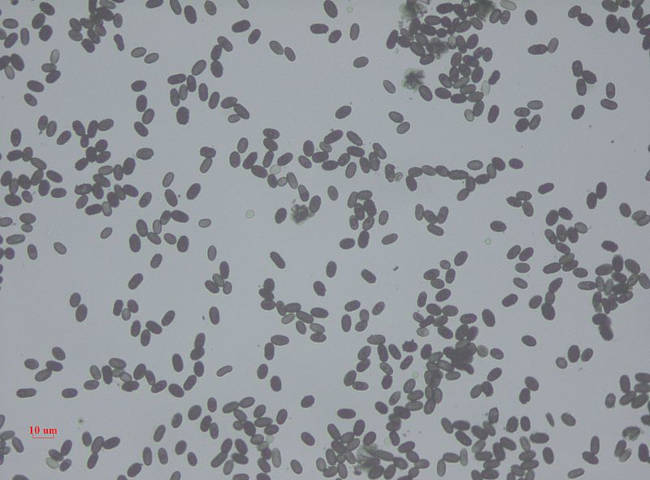
Mycotoxins linked to Parkinson's Disease:
| Mycotoxins | Mold | Description |
|---|---|---|
| Ochratoxin A | Aspergillus or Penicillium | GPL "MycoTOX profile" urine test will detect Ochratoxin A. Ochratoxin A (OTA) is a nephrotoxic, immunotoxic, and carcinogenic mycotoxin. Exposure to OTA can also come from contaminated foods such as cereals, grape juices, dairy, spices, wine, dried vine fruit, and coffee.
Ochratoxin makes a strong bond with albumin (a ubiquitouss protein component of blood) and is thus hard for the body to excrete.
References: |
| Cyclopiazonic acid | Aspergillus | Cyclopiazonic acid has been found to be a cause of Kodua poisoning characterized by somnolence (desire to sleep for long periods), tremors, and giddiness.
References: |
| Verruculogen | Aspergillus | Verruculogen is considered to be a "tremorgenic mycotoxins" which can produce a neurotoxic syndrome characterized by sustained tremors, limb weakness, ataxia and convulsions.
References: |
| 1-octen-3-ol (Mushroom Alcohol) | Mushrooms and fungi | The 1-octen-3-ol compound attacked two genes involved in the creation of dopamine – the human plasma membrane dopamine transporter (DAT) and the human VMAT ortholog (VMAT2)
References: |
The molds Penicillium and Aspergillus are often referred to as "toxic black mold" and are responsible for many serious health issues. Note that a single mold species can produce multiple mycotoxins. When a particular mold is present, the mycotoxins it produces will also be present as well. Human exposure to mycotoxins is by ingestion (food mold), inhalation and even dermal absorption and is not communicable from one person to another. Some mycotoxins such as satratoxin or trichothecene, can affect the sense of smell, cause tremors, disrupt balance or cause movement disorders but do not cause Parkinson's disease.
Also see Parkinson's Disease: A Comprehensive Analysis of Fungi and Bacteria in Brain Tissue (2020)
Environmental Mold Testing:
The US Environmental Protection Authority (EPA) has developed standards to provide an objective, sensitive and standardized way to measure mold and indoor air quality. This standard form of measurement results in an ERMI report and a value indicative of the mold toxicity of 36 different mold species or a HERTSMI-2 value which reports on 5 prominent molds. Mold tests use a technology known as Quantitative Polymerase Chain Reaction (MSQPCR), a form of DNA testing, to identify and quantify molds.
ERMI: Environmental Relative Moldiness Index
ERMI values are on a scale from -10 to 20 for each mold grouping. Values over 5 are considered high. Preferably less than 2.
HERTSMI-2: Health Effects Roster of Type-Specific Formers of Mycotoxins and Inflammagens – 2nd Version
HERTSMI-2 values of less than 10 are considered safe. The five mold species measured are Aspergilus Penicilloides, Aspergillus Versicolor, Chaetomium Globosum, Stachybotrys Chartarum and Wallemia Sebi.
Laboratories which test the environment for the presence of mold toxins:
- MycoMetrics: consumer, home mold test kits and diagnostic lab. PCR tests used to genetically identify molds.
ERMI: Environmental Relative Moldiness Index, spore counts, allergens tests, etc. ERMI test scans for 36 mold species. HERTSMI scans for only 5 mold species. - EnviroBiomics: mold test lab
ERMI: Environmental Relative Moldiness Index, spore counts, allergens tests, etc
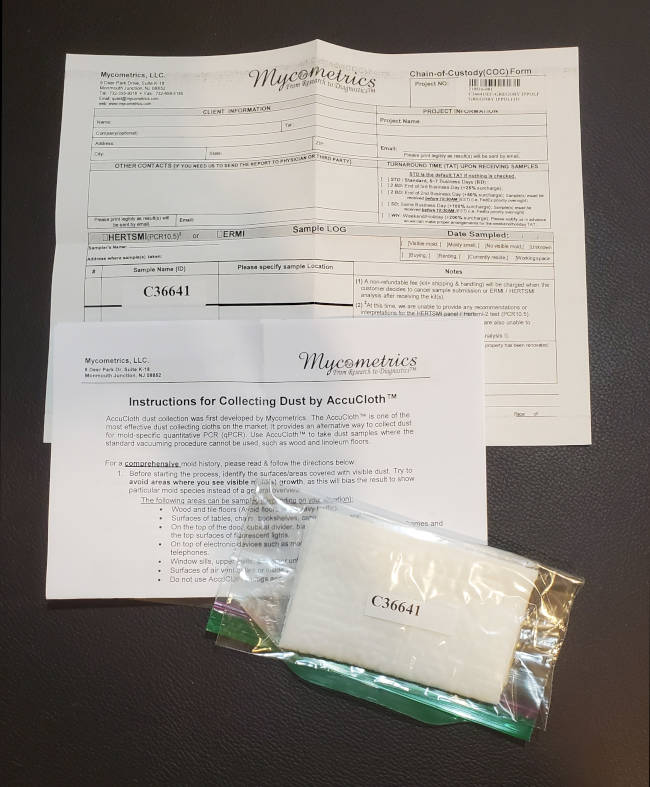
MycoMetrics consumer home mold test kit
Mycotoxins Patient Testing Laboratories:
Laboratories capable of testing human subjects to detect toxic levels of mold toxins:
- Great Plains Laboratory Inc: Lenexa KS
urine test to test one's relative exposure - myMycoLab: Florida
blood serum antibody testing for mycotoxins by testing for IgG and IgE antibodies - VibrantWellness: California
urine tests for mycotoxins, heavy metals, food sensitivities, etc
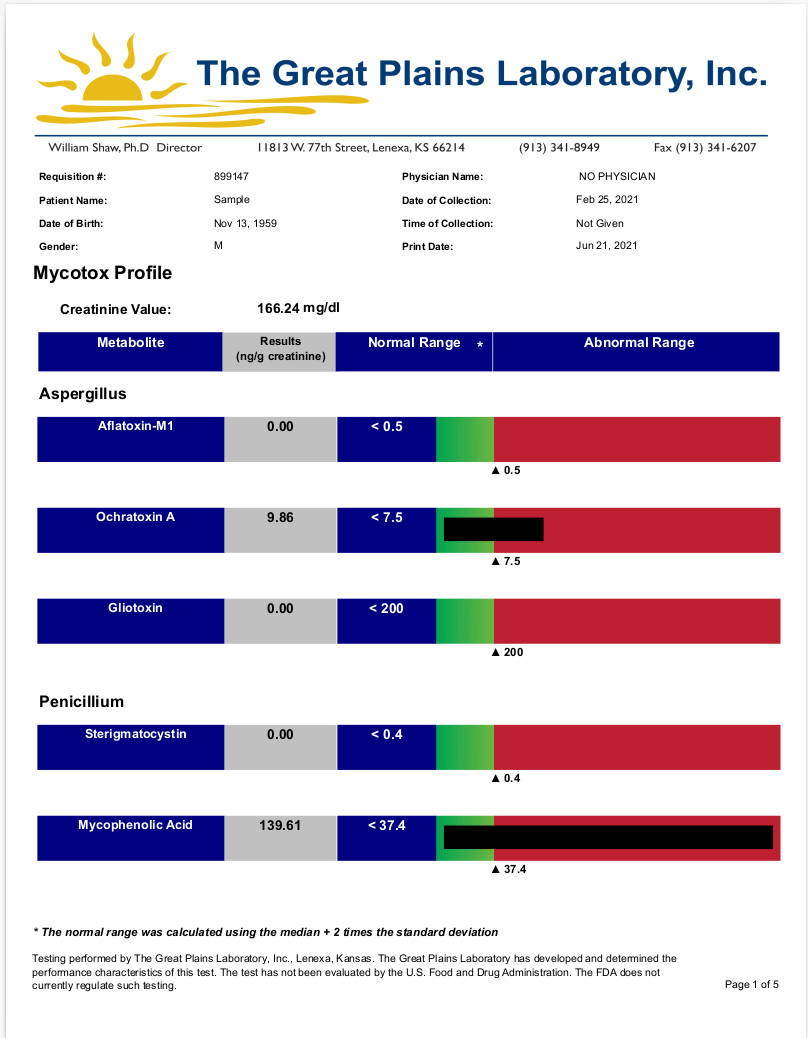
Mold Mitigation:
Mold can generate neurotoxins harmful to human life. Killing mold alone will not degrade the toxins already generated. It is essential to remove both the mold and the toxins it has generated. Mold can grow inside and outdoors, it just needs moisture and a porous surface on which to grow. Indoors this includes surfaces such as ceiling tiles, carpet and cellulose building materials like wood or fiberboard. If there is mold in your HVAC system, you may require the help from a team of professionals. Professional help may also be required if the mold has penetrated the wood structure of your house or the carpet to the point that it needs to be replaced.
Mold mitigation includes removing the source of moisture that mold thrives on and may include plumbing leaks, condensation or standing water from air conditioners, humidifiers or dehumidifiers, plant soil and pottery or roofing leaks. Mitigation also includes removal of all and any mold damaged building materials. Preferably the indoor air humidity will be kept below fifty percent (between 10-50%) to prevent its return.
Ozone Generators:
An ozone generator can be used to kill interior mold (and anything living). Ozone molecules have three oxygen atoms (O3), unlike the oxygen in the air that gives life to the planet (O2). Ozone is powerful because the extra oxygen atom can easily escape and react with living tissue. An ozone generator is not to be used while a house is inhabited as the ozone can harm lung tissue, pets and even plants. Ozone is highly reactive and will kill mold, remove organic compounds from the air and eliminate odors.
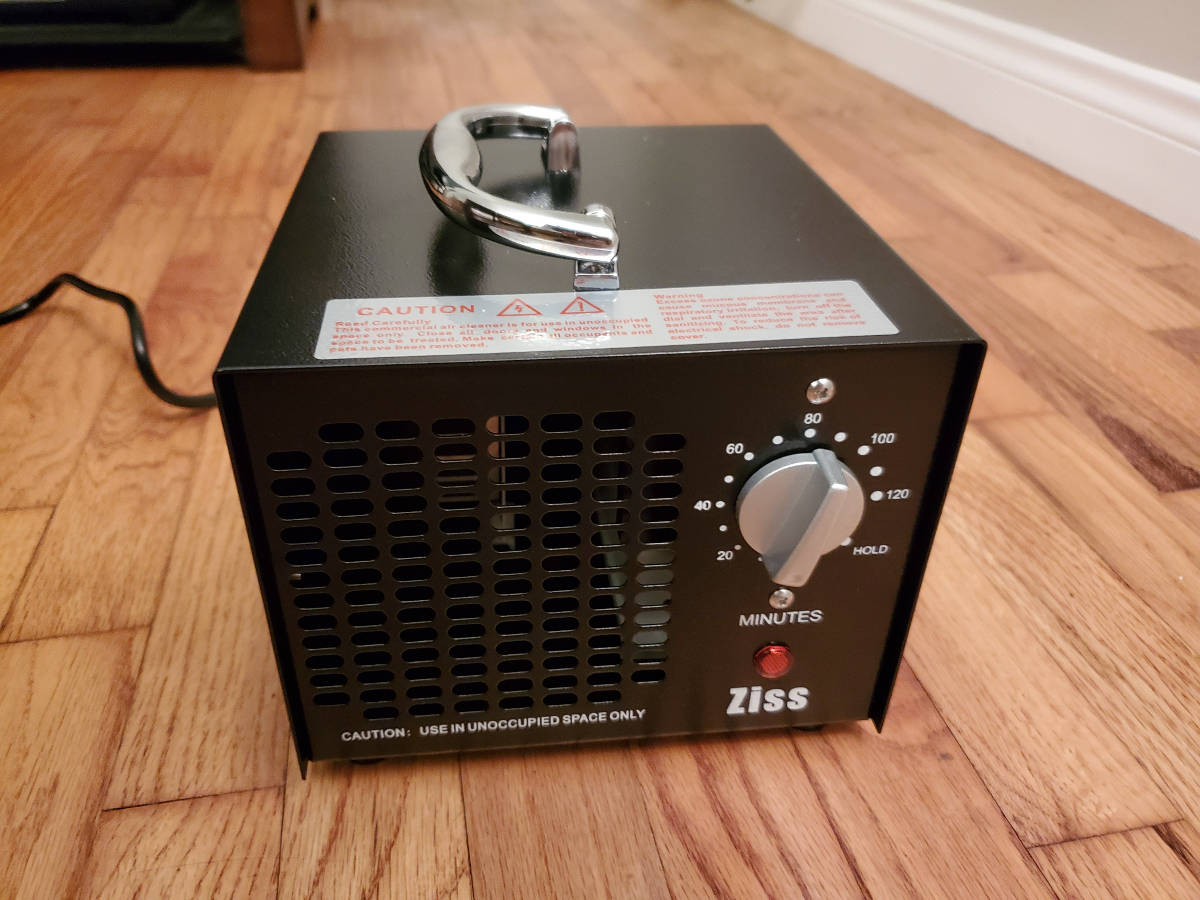
Ozone Generator (Available on Amazon): set the timer to the desired duration (eg 1 hour), leave the house for about 3 times the duration of ozone generation, air out the house and return.
Filtering Air:
Many homes used forced air ducted systems for heating and air conditioning. Use of MERV or HEPA rated filters is strongly urged. Stand-alone HEPA rated air purifiers are also available for those who's homes do not have forced air systems.
Mold spores are tiny, about 10 microns in diameter and the mycotoxins they produce are even smaller, about 0.1 microns in size (too small to be seen with a light microscope). By comparison, a human hair is about 100 microns in diameter. Note that mycotoxins are so small that even HEPA filters are ineffective in removing them. Mycotoxins are also very robust, requiring a temperature of about 500 degrees Fahrenheit (260 degrees Celcius) for about 30 minutes to break them down.
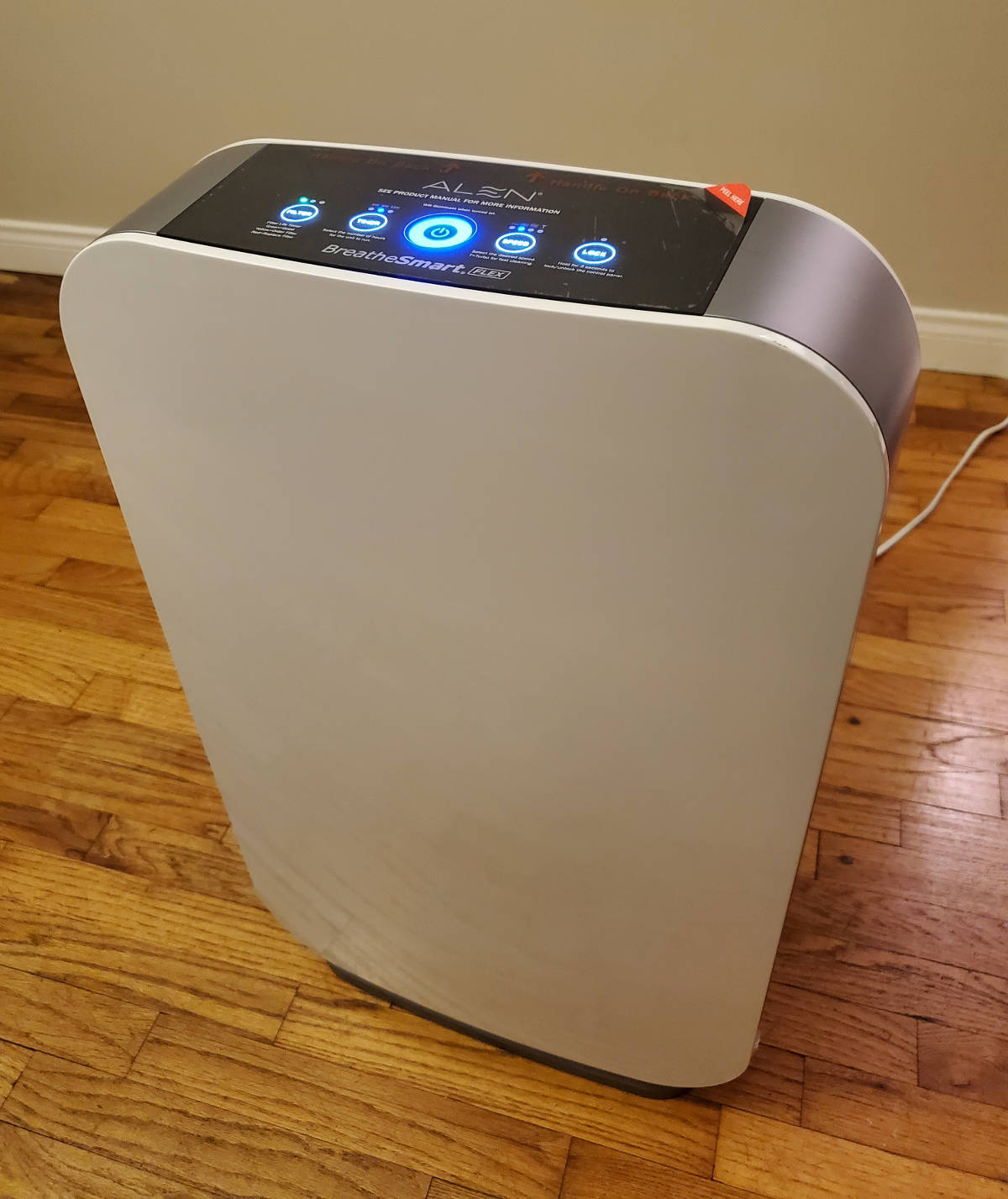
Air Purifier with HEPA filter (Available on Amazon)
Mold Removers:
The following cleaning compounds are available from your local hardware stores (Home Depot, Lowe's, ACE, True Value, ...) and can be used inside and outside to remove mold and inhibit future mold growth by acting as a anti-microbial shield.- Mold Armor Mold Remover & Disinfectant: disinfectant cleaner, sanitizer, fungicide and virucide
- Concrobium Mold control: no bleach, ammonia or VOCs
- The Mold Pros: SurfaceGuard: uses biodegradable, non-toxic, hypoallergenic, enzyme based mold cleaner
When cleaning mold, be sure to protect yourself from inhalation or incidental contact by wearing a HEPA face mask, goggles and rubber gloves.
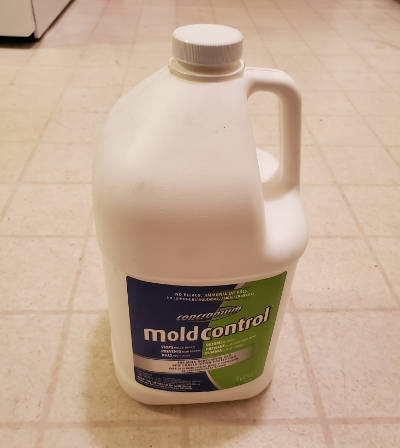
Laundry:
Add a cup of white vinegar to your load to kill mold. The following laundry cleaners are known to help:- Bleach: best used on white clothing as it may fade colors. Check for "Do not bleach" warning tags. Brands include Clorox and Oxiclean. Follow instructions for the correct quantity. Typically 1 cup per load.
- Borax (sodium tetraborate NOT boric acid): typically a half cup per load. The powder is typically prepared by mixing with hot water before adding to the laundry load.
- Vinegar: Add a cup or two to a normal wash cycle.
- Washing soda (sodium carbonate): Brands include Arm & Hammer
- Mold killing detergent: Brands include "Micro Balance EC3 Laundry Additive"
Low Mold Diet:
Food can be a source of mold, even organic food. Foods to avoid are those heavy in sugar whether it be table sugar, fructose or candy. Some fruits are notoriously high in sugar, such as ripe bananas, mangos and fruit juices. Processed foods often add sugar or fructose syrup. Examples include soft drinks, relish, breakfast cereals, soups and sauces. Sugars feed mold and help it prosper.
Foods which often harbor mold or fungal growth should also be avoided. This includes aged cheese, peanuts, dried fruits and alcoholic beverages. Foods which have a natural barrier to protect it from the environment are often safer such as meats and gourd vegetables. Root vegetables like carrots, onions, radishes and garlic often have a natural resistance. Fresh farmed produce starts healthy but over time may develop mold. Throw out old food to avoid mold.
Coffee, while wonderful, has been known to harbor Aflatoxin B1 and Ochratoxin A mycotoxins. In fact studies have shown that 45 percent of coffees sampled contained mycotoxins and that 33 percent had Ochratoxin A. Some brands take mycotoxin and pesticide exposure seriously. While we all carry a toxin burden, reducing it improves health, reduces aging and reduces a root source of Parkinson's.
Cross contamination can also occur. Throw out moldy food and keep your refrigerator clean and cold so that it does not cross contaminate your food. Cleanliness also applies to plates and storage containers.
References:- The occurrence of ochratoxin A in coffee (1995)
DOI: 10.1016/0278-6915(94)00150-m - Incidence of microflora and of ochratoxin A in green coffee beans (Coffea arabica) (2003)
DOI: 10.1080/02652030310001620405
Mold Detoxification:
Pharmaceutical antifungal treatments may include the following:
- Itraconazole: active against Aspergillus mold
- Amphotericin B: antifungal
- MicroBalance Health Products - nasal sprays and nose flushes as well as other anti-mold related products
Beyond traditional medicine, much of the advice is sketchy and does not come from the research community including the following regiment: (no proven efficacy)
- Betonite Clay topically applied to skin or taken internally: absorbs and binds to toxins. Not to be used long term.
- Raw Garlic: contains allicin which is a natural anti-fungal and anti-bacterial compound
- Activated Charcoal: binds to toxins. Not to be used long term. Must consume a large amount of water.
- Oregano: natural anti-fungal
- Green Juices:
- Cinnamon:
- Herbal Tea:
- Glutathione: boost the body's natural detoxifier with liposomal glutathione or its precursor N-acetylcysteine (NAC)
- Avoid sugar which feeds mold
Detoxification data was accumulated from various media sources.
Also see:- Zeolite (sodium aluminosilicate): Critical Review on Zeolite Clinoptilolite Safety and Medical Applications in vivo (2018)
Zeolite "Clinoptilolite" incorporated into the diet may be effective in fighting mycotoxins by direct absorption. Affinity toward aflatoxins, zearalenone, ochratoxin, and the T2 toxin was proven in vitro ..."
DOI: 10.3389/fphar.2018.01350
Quicksilver Scientific and Dr. Jill Carnahan have released a 30 day detox kit to provide a comprehensive detoxification from mold exposure. This protocol supports liver detoxification, cellular recovery, mitochondrial health and remineralization. Three phases of detox:
- Mobilize toxins: use vitamin supplements, Milk Thistle Extract, R-Lipoic Acid, DIM, NAD+, glutathione, etc
- Excrete toxins: activated charcoal, zeolite and clay binder to catch toxins in the GI tract and help carry them out of the body
- Replenish the body: vitamin supplements and remineralization to support cellular recovery, mitochondrial health and restore electrolyte balance
The length of time needed to detoxify is often related to the level and length of exposure as it directly correlates to the amount of mold buildup in the body.
Conclusion:
Mold neurotoxins can be a root cause of Parkinson's disease and one can get tested for them and remove them from the local environment.
Pros:
- No negative side effects to getting tested. Removing one's self from a moldy environment or having one's environment purged of mold and mold toxins may protect one's self from a multitude of ailments.
Cons:
- None. Rectifying a moldy environment may not halt the progression of Parkinson's or cure Parkinson's but it may remove an accelerant to one's neurological decline or other ailments.